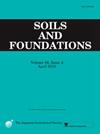Long-term settlement behavior of peat after unloading and applicability of isotach law
IF 3.3
2区 工程技术
Q2 ENGINEERING, GEOLOGICAL
引用次数: 0
Abstract
Preloading is commonly adopted to minimize the post-construction residual settlement in soft peat grounds. However, non-negligible long-term settlement can still occur during the service period of the overlying structures, posing a challenge to infrastructural maintenance. It is difficult to predict the settlement in a preloaded and then reloaded ground with a conventional creep analysis using the coefficient of secondary consolidation, Cαe. This is because the determination of its value can be subjective owing to the limited observation timescale in both the field and the laboratory, which reflects the lingering effects of the previous loading history. Thus, each value determined for Cαe is condition-specific and cannot be considered as an inherent material property. This paper investigates the viscosity characteristics of preloaded peat through long-term consolidation tests, with a particular focus on the validity of the isotach law in explaining the strain-rate effect. It is found that the peat behavior follows the isotach rule even during unloading when the overconsolidation ratio (OCR) is smaller than 1.5. The theory based on the isotach law can describe the general reloading behavior with a constant Cαe value unique to each peat, when Cαe is reappraised by applying the strain rate, rather than the conventional void ratio (e) – log time relationship. The paper also discusses how the preloading effect can be evaluated from the settlement time history during construction, giving adequate care to some important features of peat, such as the significant decrease in permeability upon consolidation.
泥炭卸荷后长期沉降行为及等附律的适用性
软泥炭地基通常采用预压的方法来减小工后残余沉降。然而,上覆结构在使用期间仍可能出现不可忽略的长期沉降,给基础设施的维护带来挑战。利用二次固结系数Cαe进行常规蠕变分析,难以预测预加载后再加载地基的沉降情况。这是因为,由于现场和实验室的观测时间尺度有限,其值的确定可能是主观的,这反映了先前加载历史的挥之不去的影响。因此,Cαe的每个值都是特定于条件的,不能被认为是固有的材料特性。本文通过长期固结试验研究了预压泥炭的黏度特性,重点研究了等压定律在解释应变率效应方面的有效性。研究发现,当超固结比(OCR)小于1.5时,泥炭在卸载过程中仍遵循等压规律。当Cαe用应变速率而不是传统的孔隙比(e) -对数时间关系来重新评价时,基于等紧律的理论可以用每个泥炭特有的常数Cαe值来描述一般的再加载行为。本文还讨论了如何根据施工过程中的沉降时间历史来评估预压效果,并充分考虑泥炭的一些重要特征,如固结后渗透性的显著降低。
本文章由计算机程序翻译,如有差异,请以英文原文为准。
求助全文
约1分钟内获得全文
求助全文
来源期刊

Soils and Foundations
工程技术-地球科学综合
CiteScore
6.40
自引率
8.10%
发文量
99
审稿时长
5 months
期刊介绍:
Soils and Foundations is one of the leading journals in the field of soil mechanics and geotechnical engineering. It is the official journal of the Japanese Geotechnical Society (JGS)., The journal publishes a variety of original research paper, technical reports, technical notes, as well as the state-of-the-art reports upon invitation by the Editor, in the fields of soil and rock mechanics, geotechnical engineering, and environmental geotechnics. Since the publication of Volume 1, No.1 issue in June 1960, Soils and Foundations will celebrate the 60th anniversary in the year of 2020.
Soils and Foundations welcomes theoretical as well as practical work associated with the aforementioned field(s). Case studies that describe the original and interdisciplinary work applicable to geotechnical engineering are particularly encouraged. Discussions to each of the published articles are also welcomed in order to provide an avenue in which opinions of peers may be fed back or exchanged. In providing latest expertise on a specific topic, one issue out of six per year on average was allocated to include selected papers from the International Symposia which were held in Japan as well as overseas.
 求助内容:
求助内容: 应助结果提醒方式:
应助结果提醒方式:


